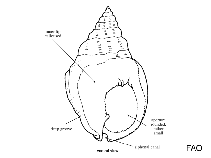Nassarius incrassatus (Stroem, 1768)
Thick lipped dog whelkWarning: DOMDocument::load(): SSL operation failed with code 1. OpenSSL Error messages: error:140770FC:SSL routines:SSL23_GET_SERVER_HELLO:unknown protocol in C:\Apache24\htdocs\includes\SpeciesSummary.lib.php on line 1236
Warning: DOMDocument::load(): Failed to enable crypto in C:\Apache24\htdocs\includes\SpeciesSummary.lib.php on line 1236
Warning: DOMDocument::load(https://sealifebase.nrm.se/webservice/AquaMaps/getAMap.php?genus=Nassarius&species=incrassatus): failed to open stream: operation failed in C:\Apache24\htdocs\includes\SpeciesSummary.lib.php on line 1236
Warning: DOMDocument::load(): I/O warning : failed to load external entity "https://sealifebase.nrm.se/webservice/AquaMaps/getAMap.php?genus=Nassarius&species=incrassatus" in C:\Apache24\htdocs\includes\SpeciesSummary.lib.php on line 1236
Upload your photos
Google image | No image available for this species;
drawing shows typical species in Nassariidae.
Google image | No image available for this species;
drawing shows typical species in Nassariidae.
Classification / Names Common names | Synonyms | CoL | ITIS | WoRMS
Gastropoda | Neogastropoda | Nassariidae
Environment: milieu / climate zone / depth range / distribution range Ecology
Demersal; depth range 3 - 30 m (Ref. 96485). Subtropical
Distribution Countries | FAO areas | Ecosystems | Occurrences | Introductions
Northeast Atlantic, Arctic and the Mediterranean. Subtropical to polar.
Length at first maturity / Size / Weight / Age
Maturity: Lm ? range ? - ? cm
Maximum depth range from Ref. 96487. Carnivore; trophic level 2.6 (Ref. 96418); also a scavenger (Ref. 96488). Found in the sublittoral zone (Ref. 96487). Inhabits rocky, detritic sandy bottoms (Ref. 96485); and soft substrata (Ref. 96488). Found also in Laminara digitata forest (Ref. 96418) and Zostera marina beds (Ref. 96488).
Life cycle and mating behavior Maturity | Reproduction | Spawning | Eggs | Fecundity | Larvae
This species is a non-broadcast spawner. Life cycle does not include trocophore stage. Also Ref. 833.
Main reference
References | Coordinator | Collaborators
Gusso, C.C., M.F. Gravina and F.R. Maggiore. 2001. (Ref. 2780)
IUCN Red List Status (Ref. 130435)
CITES status (Ref. 108899)
Not Evaluated
CMS (Ref. 116361)
Not Evaluated
Threat to humans
Human uses
| FishSource |
Tools
More information
Age/Size
Growth
Length-weight
Length-length
Morphology
Larvae
Abundance
Growth
Length-weight
Length-length
Morphology
Larvae
Abundance
Internet sources
BHL | BOLD Systems | CISTI | DiscoverLife | FAO(Publication : search) | Fishipedia | GenBank (genome, nucleotide) | GloBI | Gomexsi | Google Books | Google Scholar | Google | PubMed | Tree of Life | Wikipedia (Go, Search) | Zoological Record
Estimates based on models
Preferred temperature
(Ref. 115969): 8.8 - 19.4, mean 12.8 (based on 814 cells).
Price category
(Ref. 80766):
Unknown.



